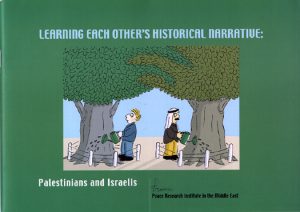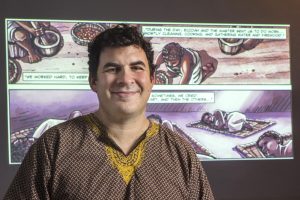History is the construction of our understanding of the past. Taking part in that process is an existential exercise which, in turn, influences our contemporary world view. These three quotes remind me about the importance and  power of narrative creation and its subsequent relationship to collective and individual identity.
power of narrative creation and its subsequent relationship to collective and individual identity.
- “It seems evident, then, that skill in narrative construction and narrative understanding is crucial to constructing our lives and a “place” for ourselves in the possible world we will encounter.” – Jerome Bruner
- ”Over time and cultures, the most robust and most effective form of communication is the creation of a powerful narrative.” – Howard Gardner
- “The universe is made of stories, not of atoms.” ― Muriel Rukeyser
Moreover, the recognition, creation, and analysis of historical narratives are essential activities for students in history classes in high school and higher education. What resources teachers use with students, as well as the explicit connection to broad concepts and contemporary realities all make for relevant and valuable teaching and learning. I had the pleasure of meeting professor Trevor Getz at a recent AHA planning meeting for the 2018 Conference being held in Washington D.C. Our interview highlights his work with students and the use of graphic novels to develop their historical thinking. Trevor can be reached at either tgetz@sfsu.edu or tgetz@ebuukuu.com
Enjoy!
1- Tell us about your journey to becoming a historian and your interest in studying Africa. I learned to love history sitting on my grandpa’s knee while he told stories of “the war.” I was the only grand kid who

Professor of History Trevor Getz, poses in front of scenes from his scholarly graphic novel “Abina and the Important Men.” Getz recently created a company called Ebuukuu.com to apply this graphic model to other areas of study. Photo by Tony Santos / Xpress
wanted to listen. I loved touching his medals, and watching as he drew pictures of fortifications, and looking through his black-and-white photo albums. I thought I wanted to be a military historian, but then as an undergraduate at Berkeley I learned to love political history, and doing my MA in Cape Town came to appreciate social history, and finally began my transition to cultural history during my PhD research at the School of Oriental and African Studies. In the process, I became immersed in the history of Africa. My first real mentor was Chris Saunders, at the University of Cape Town, who tamed my rambunctious American-ness with his precise and calm Anglo ways. Then with the larger-than-life and wonderfully inspiring professor, Richard Rathbone – truly a spectacular mentor and a fixture in the study of Ghana’s past.
2- When did graphic novels come into the mix and how have they impacted your teaching?
My dissertation (and subsequent first book) was very much a social history – putting together many different sources in an attempt to converge them on an explanation for social change in the wake of the criminalization of slavery in nineteenth century Ghana and Senegal. But in the years that followed, I learned to dig deep into single sources, figuring out how to pull apart one document or picture or diary account and explain what it meant. Most of the  sources I was working with, it turned out, featured young people – enslaved or otherwise suffering, but frequently strong and inspiring nevertheless. I wanted to bring their stories, their accounts, and their worldviews to the public. I was searching, for much of the 2000s, for a medium that would allow me to do that. I had to dig back into my own past to find one. Of course, not everyone could have a Grampa like mine to inspire them to study the past, and these stories in any case didn’t lend themselves to grandparently memory. But the other “history” inspiration of my youth was the comic book – including Franco-Belgian works like Tintin but also Art Spiegelman’s incredible Maus. So, I thought I’d experiment with comics (or the “graphic novel”) as a medium for telling the story of a young, enslaved woman who forced the government of a Crown Colony to listen to her. Thanks in part to an incredible editor (Charles Cavaliere at Oxford UP) and wonderful artist-collaborator (Liz Clarke in South Africa) it somehow worked out, and Abina and the Important Men came into being. Now we’ve developed a multi-platform app as well, for the high school classroom. Any teacher interested in trying out the app should email me.
sources I was working with, it turned out, featured young people – enslaved or otherwise suffering, but frequently strong and inspiring nevertheless. I wanted to bring their stories, their accounts, and their worldviews to the public. I was searching, for much of the 2000s, for a medium that would allow me to do that. I had to dig back into my own past to find one. Of course, not everyone could have a Grampa like mine to inspire them to study the past, and these stories in any case didn’t lend themselves to grandparently memory. But the other “history” inspiration of my youth was the comic book – including Franco-Belgian works like Tintin but also Art Spiegelman’s incredible Maus. So, I thought I’d experiment with comics (or the “graphic novel”) as a medium for telling the story of a young, enslaved woman who forced the government of a Crown Colony to listen to her. Thanks in part to an incredible editor (Charles Cavaliere at Oxford UP) and wonderful artist-collaborator (Liz Clarke in South Africa) it somehow worked out, and Abina and the Important Men came into being. Now we’ve developed a multi-platform app as well, for the high school classroom. Any teacher interested in trying out the app should email me.
3- What do you want readers to know about your award winning graphic novel, Abina and the Important Men?
This is a book about NOW, because it’s a book about power. It’s about the power that important men use to subjugate others, like Abina Mansah, who was twice enslaved and then censored and silenced. It’s about the power that even seemingly defenseless people have to make their voice heard, as Abina did in that colonial courtroom. It’s about the power that historians have (and sometimes abuse) to tell people’s stories in a way that appeals to them, and the power that we all have to challenge and correct historians’ interpretations. Power is part of any society, but we don’t have to accept the way it operates, just as Abina refused to accept attempts to silence her.
4- I argue that one of the best skills people develop from studying history is that they learn how to analyze and evaluate narratives. What do you think are some practical skills students develop by studying the past?
Historians, I firmly believe, are interpreters. The past is a foreign country, and we try to help people in the present to  understand what is said and done there, and what it means. Learning to analyze and evaluate not only primary sources but also the work of scholars is a key step in developing a critical mind and media literacy. I talk about this quite a bit in a brief video put together at SF State. I love working with teachers who develop critical tools for this kind of work as well. I especially appreciate the incredible mock trial and role playing exercises that David Sherrin from Harvest Collegiate put together to help students analyze and interpret Abina’s testimony.
understand what is said and done there, and what it means. Learning to analyze and evaluate not only primary sources but also the work of scholars is a key step in developing a critical mind and media literacy. I talk about this quite a bit in a brief video put together at SF State. I love working with teachers who develop critical tools for this kind of work as well. I especially appreciate the incredible mock trial and role playing exercises that David Sherrin from Harvest Collegiate put together to help students analyze and interpret Abina’s testimony.
5- Great. And what about the relating the study of the past to understand globalization? Any major connections?
Everything is global, right? Just like everything is local. We are much richer today for understanding the ways in which even the deep past was shaped by interaction between people, products, species, and ideas moving between societies often separated by vast distances. What we’ve learned is that in analyzing any situation in the present, we have to develop a scope that includes factors both near and far as well as from the recent and distant past. But how can we move from knowing that this need exists to actually effectively conducting analysis of global as well as local factors? That’s a difficult question, and one on which many historians are working. Obviously, we can’t answer it here. But I do have one thought that has become clear to me over the past several years: there’s no point in teaching content without teaching the underlying skills to work with and interpret it. Telling students that the global past matters doesn’t do anything unless they know how to read or view sources and pull from them the evidence of global interaction.
 6- What’s on the horizon for you and any final comments?
6- What’s on the horizon for you and any final comments?
I’m working on so many projects! I have a book on teaching African history about to come out with Duke University Press, a volume I’m co-editing with Rebecca Shumway on slavery and its legacy in Ghana and the Diaspora, and a pet long-term project using comics, other forms of art, oral tradition, and pop-up museums to understand how Ghanaians study their own past. But I’m also teaching, and being an administrator. Most of all, though, I continue to try to think of interesting strategies to engage students with the past in ways that help them to build critical and creative skills they will need for their lives moving forward.
Thank you Trevor. I look forward to future scholarship and collaboration, and wish you a great 2017!
